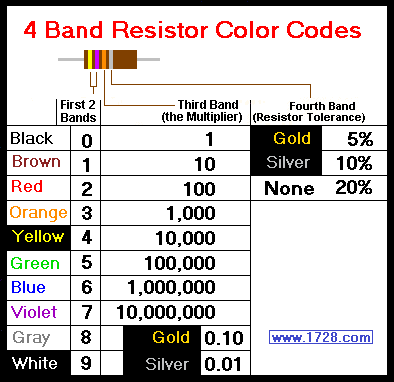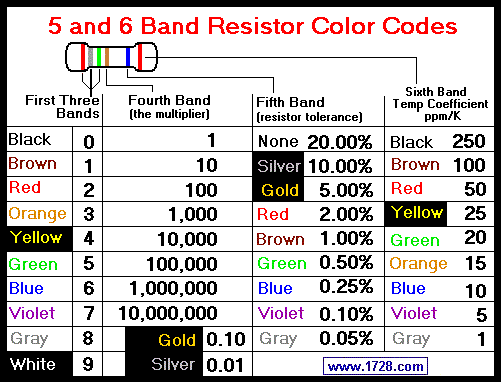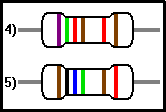|
This calculator solves for 4, 5 or 6 band resistors and is quite simple to use. To calculate a four band resistor value, use the middle four
"drop" boxes then click on the "Calc 4 Band" button. For a five or six band resistor, you can use all six boxes but all 6 do not necessarily
have to be used - the "Temperature Coefficient" box, for example. After you have selected the 6 "drop box" choices, remember to click the
"Calc 5 Band" button for your answer.


The third color band is the multiplier of the first 2 bands. Here, black is 1, brown is 10, red is 100 and so on.
Putting this in other words, the value of the third band (the multiplier) is the number 10 raised to the power of the color code. For example,
red in the third band is 10² or 100. The 4th band is the resistor's tolerance and shows how precisely the resistor was manufactured. Gold = 5%, silver = 10% and no band whatsoever = 20%. Now that we know the values of each color, let's try calculating a few examples of resistance values.
Resistor #2 has the colors orange orange yellow silver which "translates" into 3 3 ×10,000 or 330,000 ohms and a tolerance of 10%. Resistor #3 has the colors yellow violet silver meaning 4 7 ×.01 or .47 ohms and no fourth band indicates a 20% tolerance.
Use the 5 Band Chart to solve these next problems.  For resistor 4, we see the first 3 bands are violet, green and red which "translate" into 7, 5 and 2. Looking at
the fourth band (the multiplier), we see it is brown and has a value of 10. For resistor 4, we see the first 3 bands are violet, green and red which "translate" into 7, 5 and 2. Looking at
the fourth band (the multiplier), we see it is brown and has a value of 10.So, the resistance value is 7 5 2 × 10 which equals 7,520 ohms or 7.52 K ohms. Band 5 is red which indicates a 2 per cent tolerance and a brown sixth band means that the temperature coefficient is 100 parts per million (ppm).
Examining resistor 5, the first 3 bands are brown, black and blue and the fourth band (the multiplier) is green. So, these colors convert into
1 0 6 × 100,000 which calculates to 10,600,000 ohms or 10.6 Meg ohms.
Copyright © 1999 - 1728 Software Systems |
||||||

 Looking at resistor #1, we see the colors red red green gold.
Looking at resistor #1, we see the colors red red green gold.